Nickel Metal Hydride Battery Market Size
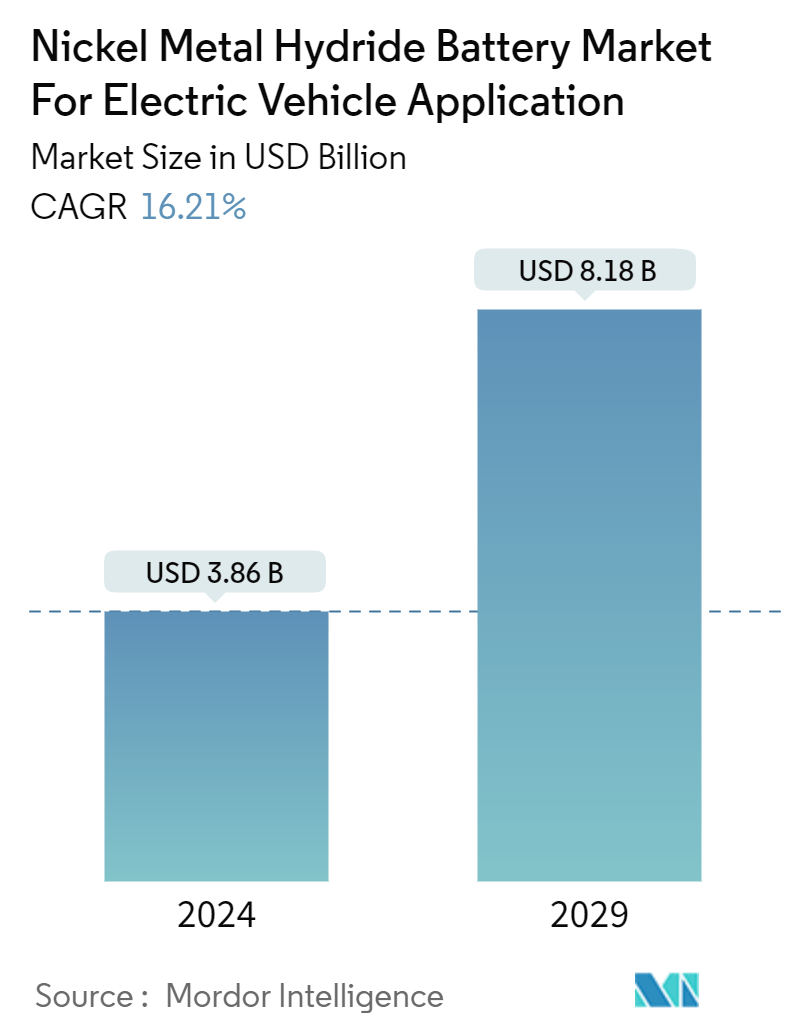
| Study Period | 2019 - 2029 |
| Market Size (2024) | USD 3.86 Billion |
| Market Size (2029) | USD 8.18 Billion |
| CAGR (2024 - 2029) | 16.21 % |
| Fastest Growing Market | Asia Pacific |
| Largest Market | North America |
| Market Concentration | High |
Major Players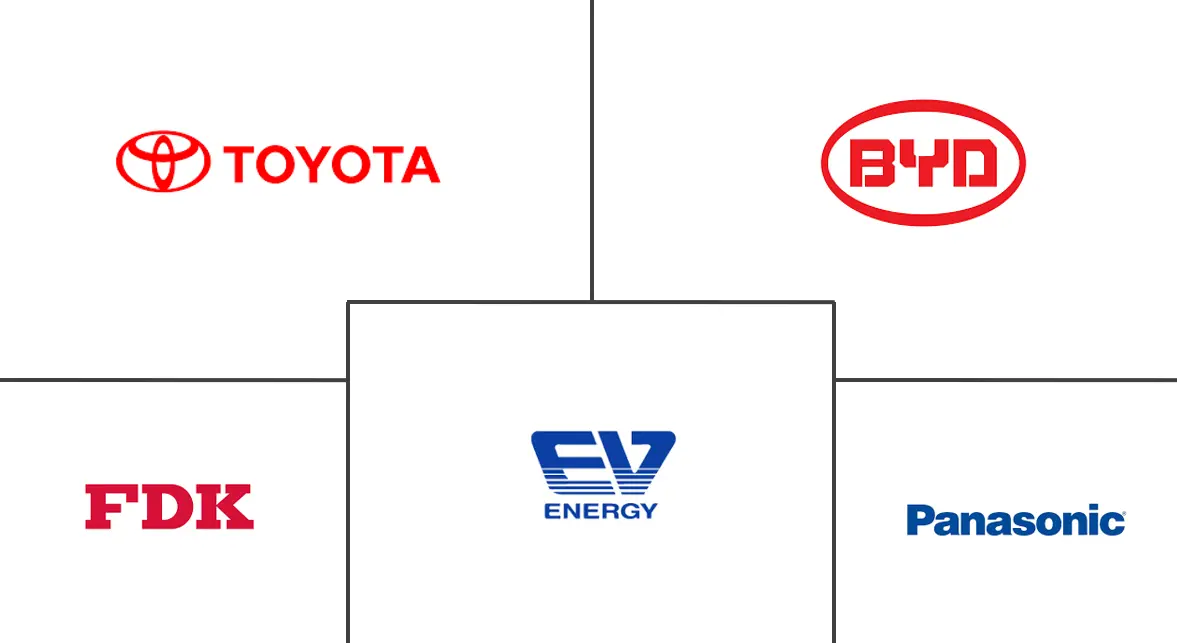
*Disclaimer: Major Players sorted in no particular order |
Nickel Metal Hydride Battery Market Analysis
The Nickel Metal Hydride Battery Market For Electric Vehicle Application Industry is expected to grow from USD 3.86 billion in 2024 to USD 8.18 billion by 2029, at a CAGR of 16.21% during the forecast period (2024-2029).
- Over the medium term, factors such as the increasing demand for electric vehicles and cost-effectiveness are expected to drive the market during the forecast period.
- On the other hand, competition from alternative technologies is expected to hinder market growth during the forecast period.
- However, technological advancements are expected to provide significant opportunities for the market in the coming years.
- Asia-Pacific is estimated to dominate the market due to the increasing adoption rate of electric vehicles across the various countries in the region.
Nickel Metal Hydride Battery Market Trends
Battery Electric Vehicles are Expected to Dominate
- Battery electric vehicles (BEVs) are electric vehicles powered entirely by rechargeable batteries with no internal combustion engine. They rely on electric motors for propulsion and store electricity in high-capacity battery packs.
- NiMH batteries have long been a popular choice for various electric vehicle applications due to their relatively high energy density, longevity, and ability to operate effectively in a range of temperatures. While lithium-ion batteries have dominated the market in recent years, NiMH batteries continue to play a significant role, especially in hybrid vehicles and some BEVs.
- The demand for BEVs has surged globally, with sales growing from 1.5 million units in 2019 to 9.5 million units in 2023. This growth is driven by increasing environmental concerns, government regulations aimed at reducing emissions, and advancements in battery technologies.
- Battery-electric cars were the third most popular choice among buyers in 2023. In December, their market share rose to 18.5%, contributing to an overall annual share of 14.6%, which surpassed diesel's steady 13.6%. Petrol vehicles maintained the top spot at 35.3%, while hybrid-electric cars held the second position with a 25.8% market share.
- However, in December 2023, new battery-electric car sales fell for the first time since April 2020, decreasing by 16.9% to 160,700 units. This decline was attributed to a strong performance in December 2022 and a notable drop in Germany, which saw a 47.6% decrease, as it is the largest market for battery-electric cars. Despite this dip, the total sales volume for the year exceeded 1.5 million units, marking a significant 37% increase compared to 2022, with the battery-electric car market share reaching 14.6%.
- Conversely, new EU registrations of hybrid-electric cars saw a 26% surge in December, driven by strong gains in three of the four largest markets: Germany (+38%), France (+32.6%), and Spain (+24.3%). This trend contributed to an overall increase of 29.5% in 2023, resulting in more than 2.7 million hybrid-electric vehicles sold, which accounted for a quarter of the EU market share.
- As the industry evolves, the continued investment in NiMH technology could lead to its resurgence in the BEV market, particularly in specific segments where its unique advantages are most beneficial. Overall, the BEV segment of the NiMH battery market is poised for growth as demand for electric vehicles rises and battery technology continues to advance.
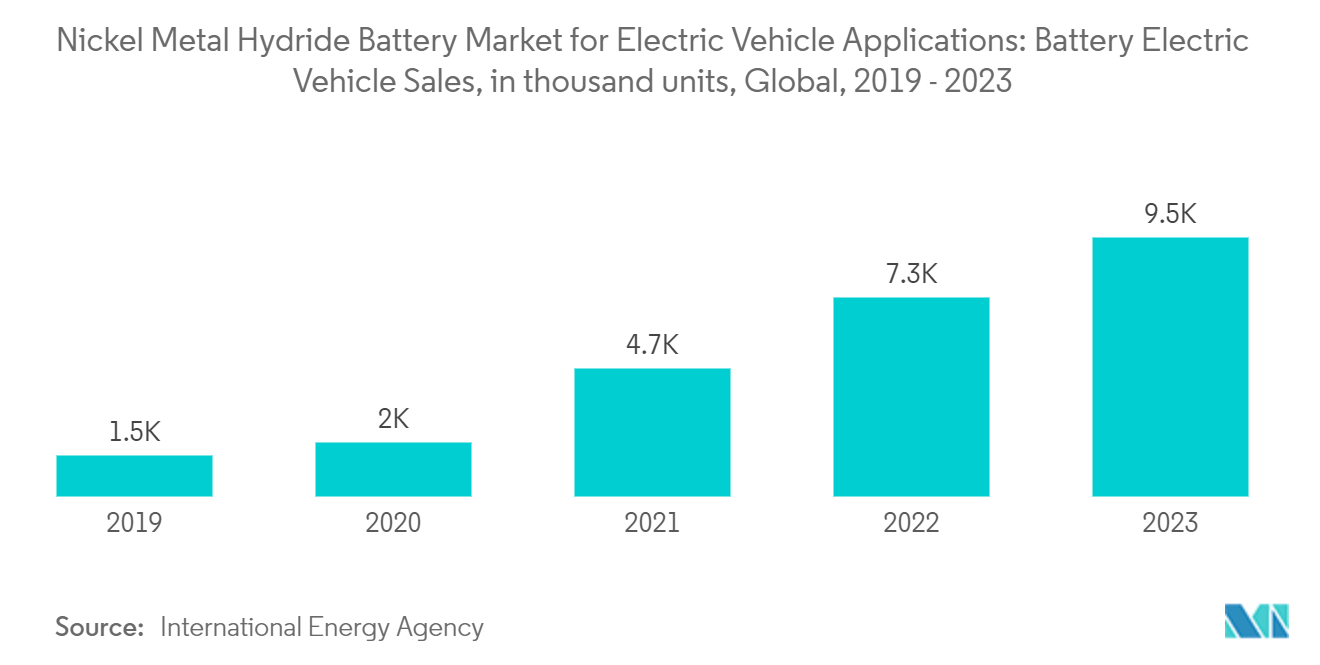
North America is Expected to Dominate
- The North American nickel-metal hydride (NiMH) battery market for electric vehicle (EV) applications is witnessing a transformative phase driven by the increasing adoption of hybrid electric vehicles (HEVs) and the push for greener transportation solutions. NiMH batteries, known for their durability, thermal stability, and cost-effectiveness, are widely utilized in HEVs due to their ability to store energy and efficiently support regenerative braking systems.
- In recent years, the demand for electric vehicles in North America has surged significantly. The growth of electric vehicle sales, which increased from 325,000 units in 2019 to approximately 1.39 million units in 2023 in the United States alone, reflects a strong consumer shift toward more sustainable transportation options. This trend is complemented by government incentives and policies promoting EV adoption and reducing greenhouse gas emissions.
- For instance, in January 2024, the Department of Treasury and the Department of Energy confirmed that the Inflation Reduction Act’s 30C for EV charging tax credit will be available to approximately two-thirds of American citizens and will provide up to 30% off the cost of the charger to individuals and businesses in low-income communities and non-urban areas, making it more affordable to install EV charging infrastructure and increasing access to EV charging in underserved communities.
- Major automotive manufacturers, particularly Toyota, have driven the NiMH battery market by integrating them into their hybrid models. Toyota’s well-established HEV lineup, which relies heavily on NiMH technology, has contributed significantly to the overall market demand. Additionally, the automotive industry's focus on improving fuel efficiency and reducing dependence on fossil fuels has further solidified the role of NiMH batteries in hybrid applications.
- Despite competition from lithium-ion batteries, which offer higher energy densities and faster charging times, NiMH batteries remain a viable option for many HEVs due to their lower costs and established manufacturing processes. Moreover, ongoing advancements in battery technology are enhancing the performance of NiMH batteries, making them more competitive in the evolving market.
- In conclusion, the North American nickel-metal hydride battery market for electric vehicle applications is positioned for growth, driven by the increasing adoption of hybrid vehicles, technological advancements, and supportive government policies. As the region continues to prioritize sustainable transportation, NiMH batteries will play a crucial role in the transition to cleaner and more efficient mobility solutions.
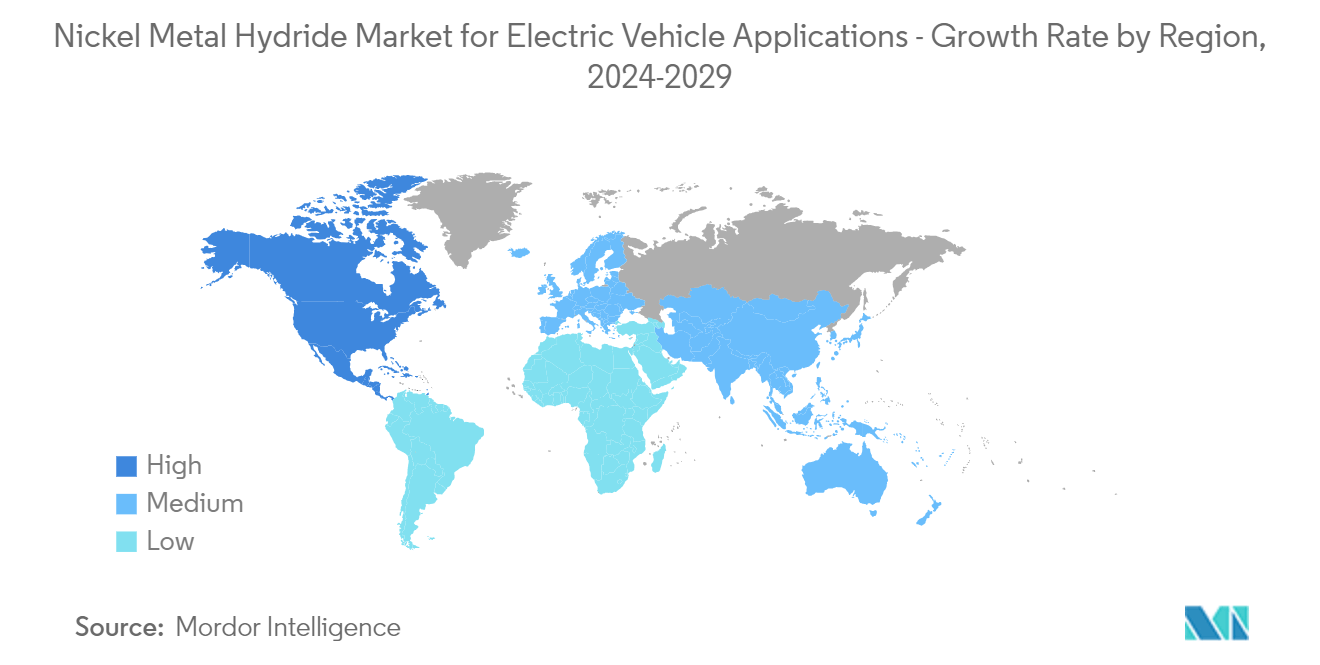
Nickel Metal Hydride Battery Industry Overview
The nickel metal hydride battery market for electric vehicle applications is consolidated. Some of the major players include (not in particular order) Panasonic Holdings Corporation, BYD Company, EV Energy Co. Ltd, FDK Corporation, and Toyota Motor Corp.
Nickel Metal Hydride Battery Market Leaders
-
Panasonic Holdings Corporation
-
BYD Company
-
FDK Corporation
-
Toyota Motor Corp
-
EV Energy Co. Ltd.
*Disclaimer: Major Players sorted in no particular order
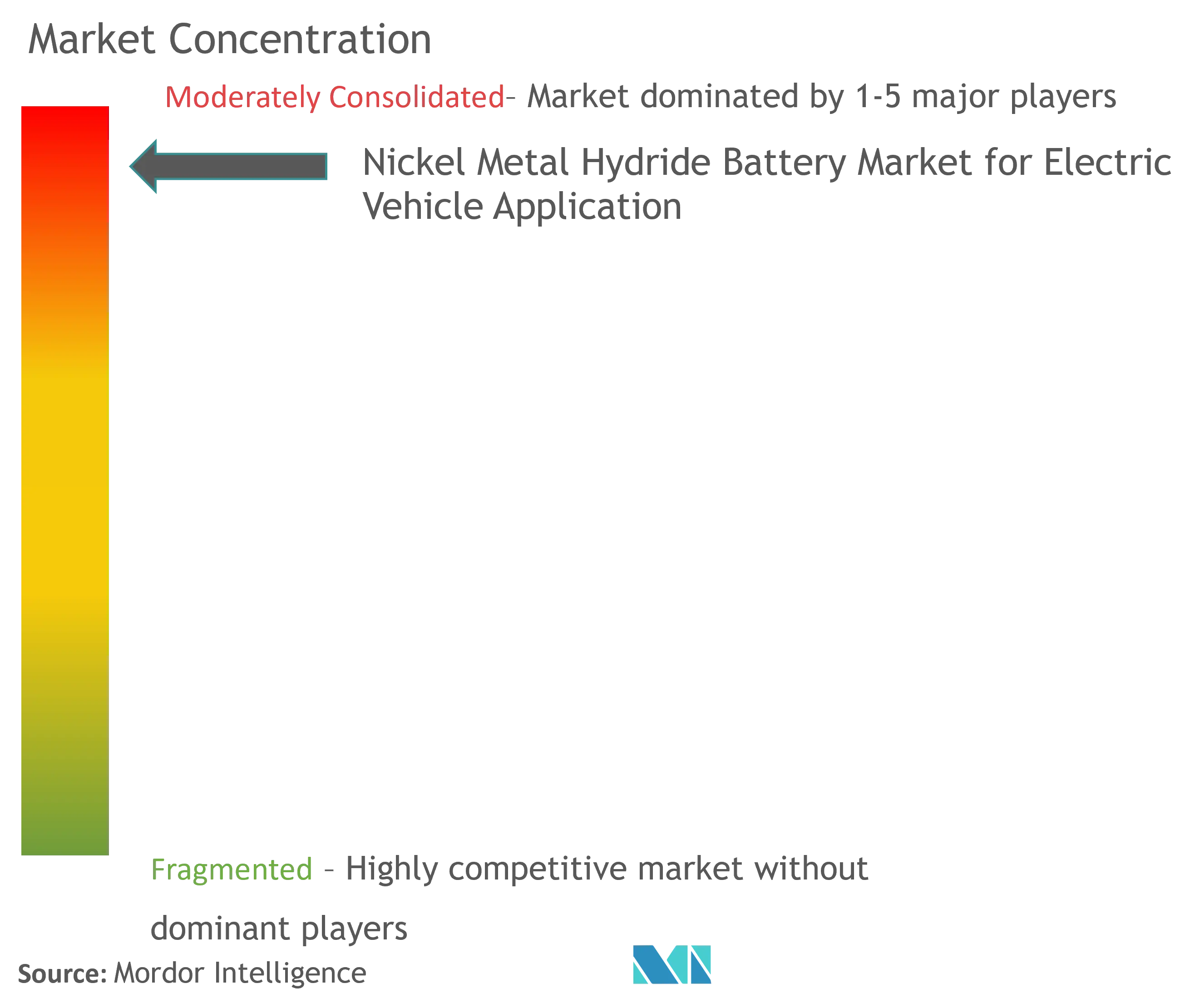
Nickel Metal Hydride Battery Market News
- February 2024: FDK CORPORATION announced the addition of the "HR-AATEZ" nickel-metal hydride battery to its product range, with mass production and shipments scheduled to begin in April 2024.
- September 2023: Atlas Materials secured USD 27 million in funding for the electric vehicle nickel-based batteries. This financial support comes ahead of the startup's plans to construct a manufacturing plant in North America. Atlas, headquartered in the United States, targets the commencement of large-scale production at one of three potential locations in Canada or the United States by 2027, aiming for an annual nickel output of 1,800 metric tons.
Nickel Metal Hydride Battery Market Report - Table of Contents
1. INTRODUCTION
1.1 Scope of Study
1.2 Market Definition
1.3 Study Assumptions
2. RESEARCH METHODOLOGY
3. EXECUTIVE SUMMARY
4. MARKET OVERVIEW
4.1 Introduction
4.2 Market Size and Demand Forecast in USD billion, till 2029
4.3 Recent Trends and Developments
4.4 Government Policies and Regulations
4.5 Market Dynamics
4.5.1 Drivers
4.5.1.1 Increasing Demand of Electric Vehicles
4.5.1.2 Cost-effectiveness
4.5.2 Restraints
4.5.2.1 Competition from Alternative Technologies
4.6 Supply Chain Analysis
4.7 Porter's Five Forces Analysis
4.7.1 Bargaining Power of Suppliers
4.7.2 Bargaining Power of Consumers
4.7.3 Threat of New Entrants
4.7.4 Threat of Substitutes Products and Services
4.7.5 Intensity of Competitive Rivalry
4.8 Investment Analysis
5. MARKET SEGMENTATION
5.1 Propulsion Type
5.1.1 Battery Electric Vehicles
5.1.2 Hybrid Electric Vehicles
5.1.3 Plug-in Hybrid Electric Vehicles
5.1.4 Fuel Cell Electric Vehicles
5.2 Vehicle Type
5.2.1 Passenger Cars
5.2.2 Commercial Vehicles
5.3 Geography
5.3.1 North America
5.3.1.1 United States
5.3.1.2 Canada
5.3.1.3 Rest of North America
5.3.2 Europe
5.3.2.1 Germany
5.3.2.2 France
5.3.2.3 United Kingdom
5.3.2.4 Spain
5.3.2.5 Italy
5.3.2.6 NORDIC
5.3.2.7 Russia
5.3.2.8 Turkey
5.3.2.9 Rest of Europe
5.3.3 Asia-Pacific
5.3.3.1 China
5.3.3.2 India
5.3.3.3 Japan
5.3.3.4 South Korea
5.3.3.5 Malaysia
5.3.3.6 Indonesia
5.3.3.7 Thailand
5.3.3.8 Vietnam
5.3.3.9 Rest of Asia-Pacific
5.3.4 South America
5.3.4.1 Brazil
5.3.4.2 Argentina
5.3.4.3 Colombia
5.3.4.4 Rest of South America
5.3.5 Middle East and Africa
5.3.5.1 Saudi Arabia
5.3.5.2 United Arab Emirates
5.3.5.3 South Africa
5.3.5.4 Qatar
5.3.5.5 Egypt
5.3.5.6 Nigeria
5.3.5.7 Rest of Middle East and Africa
6. COMPETITIVE LANDSCAPE
6.1 Mergers and Acquisitions, Joint Ventures, Collaborations, and Agreements
6.2 Strategies Adopted by Leading Players
6.3 Company Profiles
6.3.1 Panasonic Holdings Corporation
6.3.2 BYD Company
6.3.3 Toyota Motor Corp
6.3.4 FDK Corporation
6.3.5 EV Energy Co. Ltd
6.3.6 Saft Group
- *List Not Exhaustive
6.4 Market Ranking/Share Analysis
6.5 List of Other Prominent Companies
7. MARKET OPPORTUNITIES AND FUTURE TRENDS
7.1 Technological Advancements
Nickel Metal Hydride Battery Industry Segmentation
Nickel metal hydride (NiMH) batteries are a type of rechargeable battery technology that uses a nickel oxyhydroxide cathode, a hydrogen-absorbing alloy anode (typically made of rare earth metals), and an alkaline electrolyte solution. These batteries are known for their higher energy density than older technologies like nickel-cadmium (NiCd) batteries, making them suitable for applications requiring longer-lasting power sources, such as electric vehicles (EVs).
The nickel metal hydride battery market for electric vehicle applications is segmented by propulsion type, vehicle type, and geography. By propulsion type, the market is segmented into battery electric vehicles, hybrid electric vehicles, plug-in hybrid electric vehicles, and fuel cell electric vehicles). By vehicle type, the market is segmented by passenger cars and commercial vehicles. The report also covers the market size and forecasts for the market across major regions.
For each segment, the market sizing and forecasts have been done based on value (USD).
| Propulsion Type | |
| Battery Electric Vehicles | |
| Hybrid Electric Vehicles | |
| Plug-in Hybrid Electric Vehicles | |
| Fuel Cell Electric Vehicles |
| Vehicle Type | |
| Passenger Cars | |
| Commercial Vehicles |
| Geography | |||||||||||
| |||||||||||
| |||||||||||
| |||||||||||
| |||||||||||
|
Nickel Metal Hydride Battery Market Research FAQs
How big is the Nickel Metal Hydride Battery Market For Electric Vehicle Application Industry?
The Nickel Metal Hydride Battery Market For Electric Vehicle Application Industry size is expected to reach USD 3.86 billion in 2024 and grow at a CAGR of 16.21% to reach USD 8.18 billion by 2029.
What is the current Nickel Metal Hydride Battery Market For Electric Vehicle Application Industry size?
In 2024, the Nickel Metal Hydride Battery Market For Electric Vehicle Application Industry size is expected to reach USD 3.86 billion.
Who are the key players in Nickel Metal Hydride Battery Market For Electric Vehicle Application Industry?
Panasonic Holdings Corporation, BYD Company, FDK Corporation, Toyota Motor Corp and EV Energy Co. Ltd. are the major companies operating in the Nickel Metal Hydride Battery Market For Electric Vehicle Application Industry.
Which is the fastest growing region in Nickel Metal Hydride Battery Market For Electric Vehicle Application Industry?
Asia Pacific is estimated to grow at the highest CAGR over the forecast period (2024-2029).
Which region has the biggest share in Nickel Metal Hydride Battery Market For Electric Vehicle Application Industry?
In 2024, the North America accounts for the largest market share in Nickel Metal Hydride Battery Market For Electric Vehicle Application Industry.
What years does this Nickel Metal Hydride Battery Market For Electric Vehicle Application Industry cover, and what was the market size in 2023?
In 2023, the Nickel Metal Hydride Battery Market For Electric Vehicle Application Industry size was estimated at USD 3.23 billion. The report covers the Nickel Metal Hydride Battery Market For Electric Vehicle Application Industry historical market size for years: 2019, 2020, 2021, 2022 and 2023. The report also forecasts the Nickel Metal Hydride Battery Market For Electric Vehicle Application Industry size for years: 2024, 2025, 2026, 2027, 2028 and 2029.
Nickel Metal Hydride Battery Industry Report
Statistics for the 2024 Nickel Metal Hydride Battery For Electric Vehicle Application market share, size and revenue growth rate, created by Mordor Intelligence™ Industry Reports. Nickel Metal Hydride Battery For Electric Vehicle Application analysis includes a market forecast outlook for 2024 to 2029 and historical overview. Get a sample of this industry analysis as a free report PDF download.



